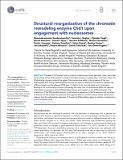Files in this item
Structural reorganization of the chromatin remodeling enzyme Chd1 upon engagement with nucleosomes
Item metadata
| dc.contributor.author | Sundaramoorthy, Ramasubramanian | |
| dc.contributor.author | Hughes, Amanda L. | |
| dc.contributor.author | Singh, Vijender | |
| dc.contributor.author | Wiechens, Nicola | |
| dc.contributor.author | Ryan, Daniel P. | |
| dc.contributor.author | El-Mkami, Hassane | |
| dc.contributor.author | Petoukhov, Maxim | |
| dc.contributor.author | Svergun, Dmitri I. | |
| dc.contributor.author | Treutlein, Barbara | |
| dc.contributor.author | Quack, Salina | |
| dc.contributor.author | Fischer, Monika | |
| dc.contributor.author | Michaelis, Jens | |
| dc.contributor.author | Böttcher, Bettina | |
| dc.contributor.author | Norman, David G. | |
| dc.contributor.author | Owen-Hughes, Tom | |
| dc.date.accessioned | 2017-04-28T09:30:13Z | |
| dc.date.available | 2017-04-28T09:30:13Z | |
| dc.date.issued | 2017-03-23 | |
| dc.identifier | 249879303 | |
| dc.identifier | d1625dd9-5b09-482f-aaca-30f806840a7c | |
| dc.identifier | 85017511461 | |
| dc.identifier | 000399016000001 | |
| dc.identifier.citation | Sundaramoorthy , R , Hughes , A L , Singh , V , Wiechens , N , Ryan , D P , El-Mkami , H , Petoukhov , M , Svergun , D I , Treutlein , B , Quack , S , Fischer , M , Michaelis , J , Böttcher , B , Norman , D G & Owen-Hughes , T 2017 , ' Structural reorganization of the chromatin remodeling enzyme Chd1 upon engagement with nucleosomes ' , eLife , vol. 6 , e22510 . https://doi.org/10.7554/eLife.22510 | en |
| dc.identifier.issn | 2050-084X | |
| dc.identifier.other | RIS: urn:A805CE685C68236CF2E50979C9337E75 | |
| dc.identifier.other | ORCID: /0000-0002-0552-5784/work/60195399 | |
| dc.identifier.uri | https://hdl.handle.net/10023/10676 | |
| dc.description | This work was funded by Wellcome Senior Fellowship 095062, Wellcome Trust grants 094090, 099149 and 097945. ALH was funded by and EMBO long-term fellowship ALTF 380–2015 co-funded by the European Commission (LTFCOFUND2013, GA-2013–609409). | en |
| dc.description.abstract | The yeast Chd1 protein acts to position nucleosomes across genomes. Here, we model the structure of the Chd1 protein in solution and when bound to nucleosomes. In the apo state, the DNA-binding domain contacts the edge of the nucleosome while in the presence of the non-hydrolyzable ATP analog, ADP-beryllium fluoride, we observe additional interactions between the ATPase domain and the adjacent DNA gyre 1.5 helical turns from the dyad axis of symmetry. Binding in this conformation involves unravelling the outer turn of nucleosomal DNA and requires substantial reorientation of the DNA-binding domain with respect to the ATPase domains. The orientation of the DNA-binding domain is mediated by sequences in the N-terminus and mutations to this part of the protein have positive and negative effects on Chd1 activity. These observations indicate that the unfavorable alignment of C-terminal DNA-binding region in solution contributes to an auto-inhibited state. | |
| dc.format.extent | 28 | |
| dc.format.extent | 5931693 | |
| dc.language.iso | eng | |
| dc.relation.ispartof | eLife | en |
| dc.subject | Chd1 | en |
| dc.subject | Nucleosome | en |
| dc.subject | Chromatin remodeling | en |
| dc.subject | ATPase | en |
| dc.subject | QH426 Genetics | en |
| dc.subject | QH301 Biology | en |
| dc.subject | QD Chemistry | en |
| dc.subject | DAS | en |
| dc.subject.lcc | QH426 | en |
| dc.subject.lcc | QH301 | en |
| dc.subject.lcc | QD | en |
| dc.title | Structural reorganization of the chromatin remodeling enzyme Chd1 upon engagement with nucleosomes | en |
| dc.type | Journal article | en |
| dc.contributor.sponsor | The Wellcome Trust | en |
| dc.contributor.institution | University of St Andrews. School of Physics and Astronomy | en |
| dc.identifier.doi | 10.7554/eLife.22510 | |
| dc.description.status | Peer reviewed | en |
| dc.identifier.grantnumber | 099149/Z/12/Z | en |
This item appears in the following Collection(s)
Items in the St Andrews Research Repository are protected by copyright, with all rights reserved, unless otherwise indicated.

